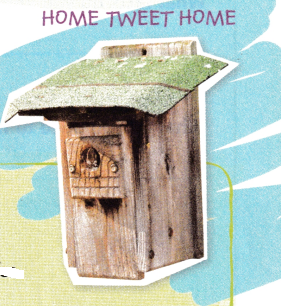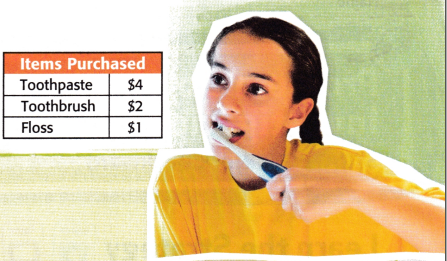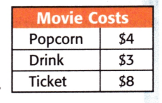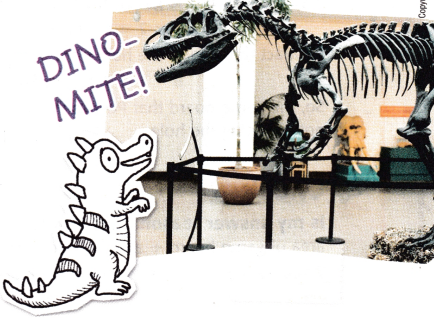All the solutions provided in McGraw Hill My Math Grade 5 Answer Key PDF Chapter 7 Lesson 4 Problem-Solving Investigation: Work Backward will give you a clear idea of the concepts.
McGraw-Hill My Math Grade 5 Answer Key Chapter 7 Lesson 4 Problem-Solving Investigation: Work Backward
Learn the Strategy
The Nature Club raised $125 to buy and install bird houses at a wildlife site. Each house costs $5. It costs $75 to rent a bus so the members can travel to the site. How many boxes can the club buy?

1. Understand
What facts do you know?
___________ is available to buy and install the nesting boxes.
Each box costs ___________ and the bus rental costs ___________.
What do you need to find?
How many ____________ can the club buy?
Answer:
Fund is available to buy and install the nesting boxes.
Each box costs $5 and the bus rental costs $75.
Need to find the number of boxes required.
How many boxes can the club buy.
2. Plan
I can work backward to solve the problem.
Answer:
yes, by multiplying the numbers of boxes with the cost of each box.
3. Solve
Subtract the cost of the bus. Then divide by the cost for each box.
$125 – $75 = _____________
__________ ÷ $5 = ____________
So, ____________ boxes can be bought.
Answer:
$125 – $75 = $50
$50 ÷ 5 = 10 boxes.
So, 10 boxes can be bought.
4. Check
Is my answer reasonable? Explain.
Multiply. ____________ × $5 = Add.
___________ + $75 = $125
Answer:
10 × $5 = $50.
$50 + $75 = $125
So, my answer is reasonable.
Explanation:
The Nature Club raised $125 to buy and install bird houses at a wildlife site.
Each house costs $5.
It costs $75 to rent a bus so the members can travel to the site.
Number of boxes can the club buy,
$125 – $75 = $50
$50 ÷ 5 = 10 boxes.
Whether the answer is reasonable or not, we can do backward calculation.
Cost of each box = $5
Number of boxes required = 10
Cost of the ten boxes 10 x 5 = $50
Practice the Strategy
Mr. Evans bought the items listed. He had $5 left over. How much did Mr. Evans have to start with?

1. Understand
What facts do you know?
What do you need to find?
2. Plan
3. Solve
4. Check
Is my answer reasonable? Explain.
Answer:
1. Understand:
Mr. Evans bought the items listed.
He had $5 left over.
How much did Mr. Evans have to start with?
2. Plan:
By backward calculation.
3. Solve:
Toothpaste – $4
Tooth brush – $2
Floss – $1
Amount left with her = $5
Mr. Evans have to start with = Total items + Amount left
= $4 + $2 + $1 +$ 5 = $12
4. Check:
Yes, Answer is reasonable.
Explanation:
Mr. Evans bought the items listed,
Toothpaste – $4
Tooth brush – $2
Floss – $1
He had $5 left over.
Mr. Evans have to start with = Total items + Amount left
= $4 + $2 + $1 +$ 5 = $12.
Apply the Strategy
Solve each problem by working backward.
Question 1.
Seth bought a movie ticket, popcorn, and a drink. After the movie, he played 4 video games that each cost the same. He spent a total of $19. How much did it cost to play each video game?

Answer:
$1
Explanation:
Cost of Popcorn = $4
Cost of Drink = $3
Cost of Ticket = $8
Total cost of items = $4 + $3 + $8 = $15.
After the movie, he played 4 video games that each cost the same.
He spent a total of $19.
Cost of four video games = $19 – $15 = $4
Cost of each video game = Cost of video game ÷ Number of video games.
4 ÷ 4 = $1
Check: Multiply 4 video games with cost of 1 video game = 4 x 1 = $4
Question 2.
Students sold raffle tickets to raise money for a field trip. The first 20 tickets sold cost $4 each. To sell more tickets, they lowered the price to $2 each. If they raise $216, how many tickets did they sell in all?
Answer:
88 tickets.
Explanation:
The first 20 tickets sold cost $4 each.
20 x 4 = $80
To sell more tickets, they lowered the price to $2 each.
If they raise $216,
$216 – $80 = $136
136 ÷ 2 = 68 tickets
No. of tickets they sell in all 20 + 68 = 88 tickets.
Question 3.
Jeanette’s sister charges $5.50 per hour before 9:00 P.M. for babysitting and $8 per hour after 9:00 P.M. She finished babysitting at 11:00 P.M. and earned $38. At what time did she begin babysitting?
Answer:
5:00 P.M.
Explanation:
Jeanette’s sister charges $5.50 per hour before 9:00 P.M. for babysitting.
$8 per hour after 9:00 P.M.
She finished babysitting at 11:00 P.M.
From 9:00 P.M -11:00 P.M she earned = $8 x 2 = $16.
Total amount she earned $38.
Before 9:00 P.M she earned $38 – $16 = $22
$22 ÷ 5.50 = 4hours.
9 minus four equals = 5,
So she started babysitting at 5:00 P.M.
Question 4.
Mathematical PRACTICE Use Algebra Work backward to find the value of the variable in the equation below.
d + 4 = 19
Answer:
Explanation:
d + 4 = 19
d = 19 – 4
d = 15
Backward strategy,
15 + 4 = 19
Question 5.
Allie collected 15 more cans of food than Peyton. Ling collected 8 more than Allie. Ling collected 72 cans of food. How many cans of food did Peyton collect?

Answer:
Peyton collected 49 cans.
Explanation:
Let x be the number of cans of food Peyton collected.
So, that Allie collected x + 15 cans of food.
Ling collected (x + 15) + 8 = x + 23 cans of food.
Given that Ling collected 72 cans of food,
we can write: x + 23 = 72 cans.
x = 72 – 23 = 49 cans.
Substitute the x value for Allie
So, Allie collected x + 15 = 49 + 15 = 64 cans.
Review the Strategies
Use any strategy to solve each problem.
- Work backward.
- Make a table.
- Solve a simpler problem.
- Determine extra or missing information.
Question 6.
Rebecca sold 11 more magazine subscriptions than Chad. Laura sold 4 more than Rebecca. Laura sold 45 magazine subscriptions. How many magazine subscriptions did Chad sell?
Answer:
30 magazine subscriptions
Explanation:
Given that Laura sold 4 more than Rebecca.
Then, number of magazines sold by Laura will be ,
4 + n + 11 ⇒ n + 15.
Laura sold 45 magazine subscriptions.
Total magazine subscriptions sold by Chad = 45 – 15 = 30
Rebecca sold 11 more magazine subscriptions than Chad.
11 + 30 = 41
Question 7.
Mathematical PRACTICE Look for a Pattern Frankie is planning to buy a new MP3 player for $90. Each month he doubles the amount he saved the previous month. If he saves $3 the first month, in how many months will Frankie have enough money to buy the MP3 player?
Answer:
6 months.
Pattern:
Double the number in series.
Explanation:
Frankie is planning to buy a new MP3 player for $90.
Each month he doubles the amount he saved the previous month.
If he saves $3 the first month,
Second month he doubles the savings as $3 + $3 = $6
Third month he doubles his savings as $6 + $6 = $12
Fourth month he doubles his savings as $12 + $12 = $24
Fifth month he doubles his savings as $24 + $24 = $48
Sixth month he doubles his savings as $48 + $48 = $96
Question 8.
The table shows the number of miles Michael ran each day over the past four days. How many more miles did he run on day 3 than on day 2? Determine if there is extra or missing information.

Answer:
There is extra information.
The information of day four is not required,
to know more miles he run on day 3 than on day 2.
Explanation:
To know more miles he run on day 3 than on day 2,
day 3 he run 7 miles,
day 2 he run 2 miles,
No. of more miles between day 3 and day 2 = 7 – 2 = 5 miles.
Question 9.
Mrs. Stevens is delivering flowers to a local flower shop. She delivers the same number of flowers with each delivery. The flower shop has ordered 2,050 flowers and it will take 5 trips to deliver all the flowers. How many flowers will Mrs. Stevens have delivered after 4 trips?
Answer:
1,640 flowers.
Explanation:
The flower shop has ordered 2,050 flowers in 5 trips.
2050 ÷ 5 = 410
Each trip she delivers 410 flowers.
No. of flowers will Mrs. Stevens have delivered after 4 trips,
410 x 4 = 1,640 flowers.
Question 10.
Admission to a car show costs $5 for each ticket. After selling only 20 tickets, they decided to lower the price to $3 each. If they raise $217, how many tickets did they sell in all?
Answer:
59 tickets.
Explanation:
Admission to a car show costs $5 for each ticket.
firstly 20 tickets were sold each $5 = $5 x 20 = $100.
If they raise $217, tickets sold in all $217 – $100 = 1 = $117.
After selling only 20 tickets, they decided to lower the price to $3 each.
$117 ÷ $3 = 39.
20 + 39 = 59
So, they sold 59 tickets that night.
McGraw Hill My Math Grade 5 Chapter 7 Lesson 4 My Homework Answer Key
Problem Solving
Solve each problem by working backward.
Question 1.
The science club raised money to clean the beach. They spent $29 on trash bags and $74 on waterproof boots. They still have $47 left. How much did they raise?
Answer:
$150
Explanation:
The science club spent $29 on trash bags,
$74 on waterproof boots.
Total amount spent on trash bags and waterproof boots,
$29 + $74 = $103
They still have $47 left.
Total amount raised by science club = $103 + $47 = $150
Question 2.
Mr. Charles cut fresh roses from his garden and gave 10 roses to his neighbor. Then he gave half of what was left to his niece. He kept the remaining 14 roses. How many roses did he cut?
Answer:
38 roses.
Explanation:
Let x be the number of roses Mr. Charles had cut from his garden.
After giving 10 roses to his neighbour,
he has (x – 10) roses.
Then he gave half of what was left to his niece.
(x – 10) ÷ 2
He kept the remaining 14 roses.
No. of roses he cut from his garden (x – 10) ÷ 2 = 14
(x – 10) = 2 x 14
(x – 10) = 28
x = 28 + 10 = 38 roses
Question 3.
Mathematical PRACTICE Use Number Sense A number is divided by 6. Then 8 is added to the quotient. Next 3 is subtracted from the sum. The result is 7. What is the number?
Answer:
12
Explanation:
Let the number be N.
A number is divided by 6 = N ÷ 6
Then 8 is added to the quotient.
N ÷ 6 + 8
Next 3 is subtracted from the sum,
N ÷ 6 + 8 – 3 = 7 simplify
N ÷ 6 + 5 = 7
subtract 5 from both sides
N ÷ 6 = 7 – 5
N ÷ 6 = 2 multiply both sides by 6
N = 6 x 2 = 12
Question 4.
Hoover Dam, in the United States, is 223 meters high. Ertan Dam, in China, is 240 meters high. Write and evaluate a numerical expression to find the difference between the heights of the two dams.
Answer:
Ertan Dam, in China, is 17 meters high than Hoover Dam, in the United States.
Explanation:
Subtract less meters of dam from the more meters of dam.
240 – 223 = 17 meters.
Question 5.
Ms. Houston’s fifth-grade class is going to a museum. The class raises $68 for the trip. Transportation to the museum costs $40. The museum sells small fossils for $4 each. How many fossils can they buy with the money they have left?

Answer:
7 fossils.
Explanation:
The class raises $68 for the trip.
Transportation to the museum costs $40.
$68 – $40 = $28
The museum sells small fossils for $4 each.
No. of fossils they buy with the money they have left,
28 ÷ 4 = 7 fossils.